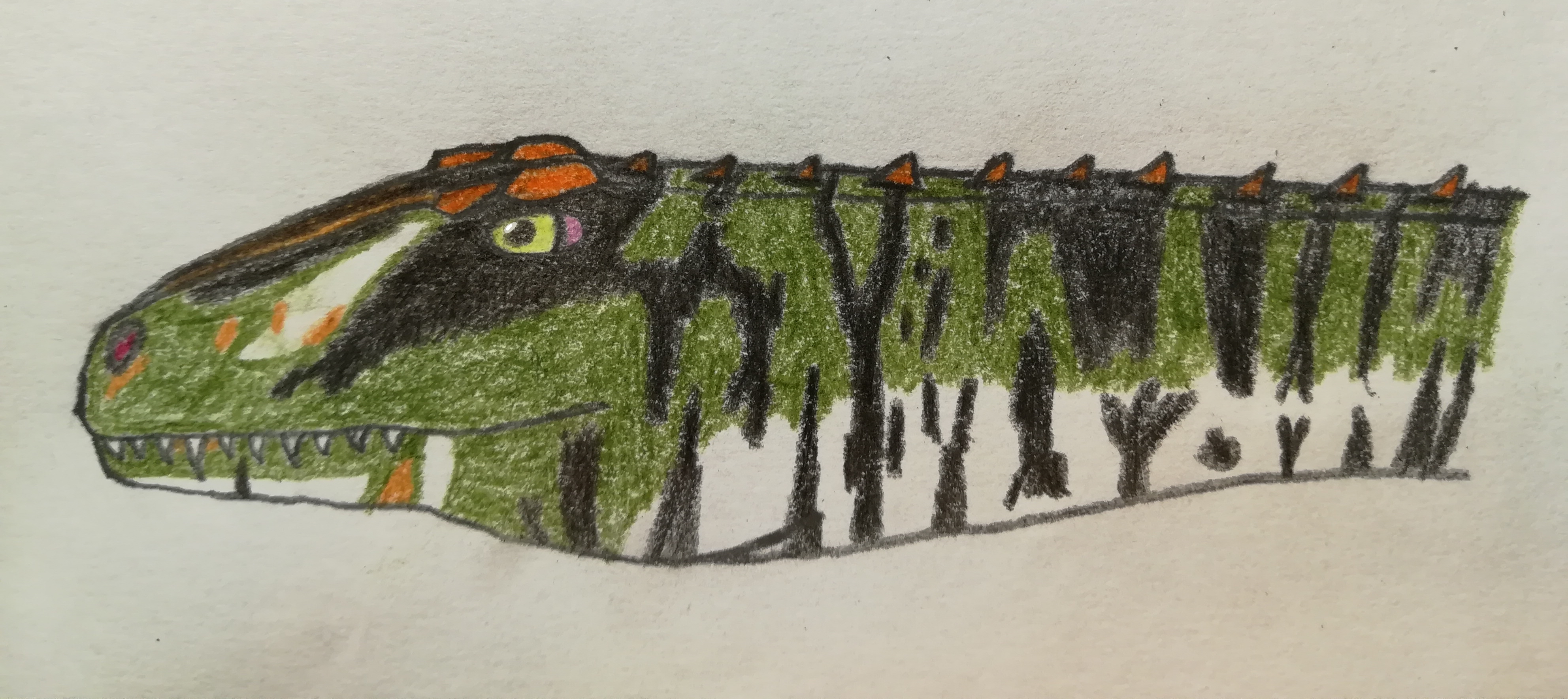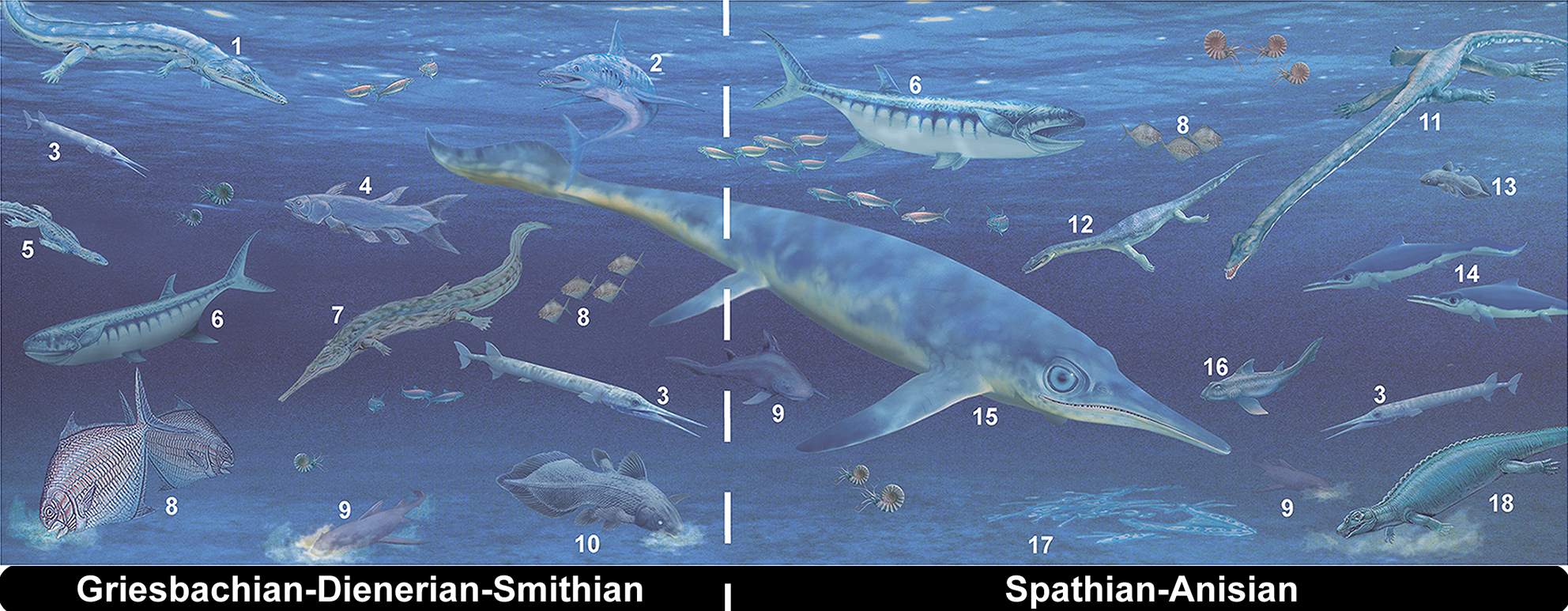|
Collilongus
''Collilongus'' (meaning "long neck") is an extinct genus of small archosauriform, possibly a rauisuchian, known from Early Triassic (Olenekian age) rocks of Czatkowice 1, Poland. It was first named by Magdalena Borsuk−Białynicka; and Andriej G. Sennikov in 2009. The type and only known species is ''Collilongus rarus''. It is a rare component of the Czatkowice 1 fauna, known only from vertebrae. ''Collilongus'' was a contemporary of the more common archosauriform ''Osmolskina left, 210px, Fossil elements. ''Osmolskina'' is a genus of archosauriform reptile which lived during the Early Triassic in what is now Poland. The type species, ''Osmolskina czatkowicensis'', was described by Magdalena Borsuk−Białynicka and ...''. References Early Triassic reptiles of Europe Prehistoric archosauriforms Fossil taxa described in 2009 Fossils of Poland Prehistoric reptile genera {{triassic-reptile-stub ... [...More Info...] [...Related Items...] OR: [Wikipedia] [Google] [Baidu] |
Collilongus Head
''Collilongus'' (meaning "long neck") is an extinct genus of small archosauriform, possibly a rauisuchian, known from Early Triassic (Olenekian age) rocks of Czatkowice 1, Poland. It was first named by Magdalena Borsuk−Białynicka; and Andriej G. Sennikov in 2009. The type and only known species is ''Collilongus rarus''. It is a rare component of the Czatkowice 1 fauna, known only from vertebrae. ''Collilongus'' was a contemporary of the more common archosauriform ''Osmolskina left, 210px, Fossil elements. ''Osmolskina'' is a genus of archosauriform reptile which lived during the Early Triassic in what is now Poland. The type species, ''Osmolskina czatkowicensis'', was described by Magdalena Borsuk−Białynicka and ...''. References Early Triassic reptiles of Europe Prehistoric archosauriforms Fossil taxa described in 2009 Fossils of Poland Prehistoric reptile genera {{triassic-reptile-stub ... [...More Info...] [...Related Items...] OR: [Wikipedia] [Google] [Baidu] |
Archosauriformes
Archosauriformes ( Greek for 'ruling lizards', and Latin for 'form') is a clade of diapsid reptiles that developed from archosauromorph ancestors some time in the Latest Permian (roughly 252 million years ago). It was defined by Jacques Gauthier (1994) as the clade stemming from the last common ancestor of Proterosuchidae and Archosauria (the group that contains crocodiles, pterosaurs and dinosaurs ncluding birds; Phil Senter">bird">ncluding_bird<_a>s.html" ;"title="bird.html" ;"title="ncluding bird">ncluding birds">bird.html" ;"title="ncluding bird">ncluding birds; Phil Senter (2005) defined it as the most exclusive clade containing ''Proterosuchus'' and Archosauria. These reptiles, which include members of the family Proterosuchidae and more advanced forms, were originally superficially crocodile-like animals with sprawling gaits and long snouts. Unlike the bulk of their therapsid contemporaries, the proterosuchids survived the catastrophe at the end o ... [...More Info...] [...Related Items...] OR: [Wikipedia] [Google] [Baidu] |
Genus
Genus ( plural genera ) is a taxonomic rank used in the biological classification of living and fossil organisms as well as viruses. In the hierarchy of biological classification, genus comes above species and below family. In binomial nomenclature, the genus name forms the first part of the binomial species name for each species within the genus. :E.g. '' Panthera leo'' (lion) and '' Panthera onca'' (jaguar) are two species within the genus ''Panthera''. ''Panthera'' is a genus within the family Felidae. The composition of a genus is determined by taxonomists. The standards for genus classification are not strictly codified, so different authorities often produce different classifications for genera. There are some general practices used, however, including the idea that a newly defined genus should fulfill these three criteria to be descriptively useful: # monophyly – all descendants of an ancestral taxon are grouped together (i.e. phylogenetic analysis should c ... [...More Info...] [...Related Items...] OR: [Wikipedia] [Google] [Baidu] |
Fossil Taxa Described In 2009
A fossil (from Classical Latin , ) is any preserved remains, impression, or trace of any once-living thing from a past geological age. Examples include bones, shells, exoskeletons, stone imprints of animals or microbes, objects preserved in amber, hair, petrified wood and DNA remnants. The totality of fossils is known as the ''fossil record''. Paleontology is the study of fossils: their age, method of formation, and evolutionary significance. Specimens are usually considered to be fossils if they are over 10,000 years old. The oldest fossils are around 3.48 billion years old to 4.1 billion years old. Early edition, published online before print. The observation in the 19th century that certain fossils were associated with certain rock strata led to the recognition of a geological timescale and the relative ages of different fossils. The development of radiometric dating techniques in the early 20th century allowed scientists to quantitatively measure the absolute ... [...More Info...] [...Related Items...] OR: [Wikipedia] [Google] [Baidu] |
Prehistoric Archosauriforms
Prehistory, also known as pre-literary history, is the period of human history between the use of the first stone tools by hominins 3.3 million years ago and the beginning of recorded history with the invention of writing systems. The use of symbols, marks, and images appears very early among humans, but the earliest known writing systems appeared 5000 years ago. It took thousands of years for writing systems to be widely adopted, with writing spreading to almost all cultures by the 19th century. The end of prehistory therefore came at very different times in different places, and the term is less often used in discussing societies where prehistory ended relatively recently. In the early Bronze Age, Sumer in Mesopotamia, the Indus Valley Civilisation, and ancient Egypt were the first civilizations to develop their own scripts and to keep historical records, with their neighbors following. Most other civilizations reached the end of prehistory during the following Iron Age. ... [...More Info...] [...Related Items...] OR: [Wikipedia] [Google] [Baidu] |
Early Triassic Reptiles Of Europe
Early may refer to: History * The beginning or oldest part of a defined historical period, as opposed to middle or late periods, e.g.: ** Early Christianity ** Early modern Europe Places in the United States * Early, Iowa * Early, Texas * Early Branch, a stream in Missouri * Early County, Georgia Other uses * ''Early'' (Scritti Politti album), 2005 * ''Early'' (A Certain Ratio album), 2002 * Early (name) * Early effect, an effect in transistor physics * Early Records, a record label * the early part of the morning Morning is the period from sunrise to noon. There are no exact times for when morning begins (also true of evening and night) because it can vary according to one's lifestyle and the hours of daylight at each time of year. However, morning stric ... See also * Earley (other) {{disambiguation, geo ... [...More Info...] [...Related Items...] OR: [Wikipedia] [Google] [Baidu] |
Osmolskina
left, 210px, Fossil elements. ''Osmolskina'' is a genus of archosauriform reptile which lived during the Early Triassic in what is now Poland. The type species, ''Osmolskina czatkowicensis'', was described by Magdalena Borsuk−Białynicka and Susan Evans in 2003. The generic name honors the late female Polish paleontologist Halszka Osmólska. ''Osmolskina'' closely resembles the well-known genus ''Euparkeria''. The authors of the 2003 paper considered classifying ''Osmolskina'' within the family Euparkeriidae, noting the animal's close resemblance to ''Euparkeria ''Euparkeria'' (; meaning "Parker's good animal", named in honor of W.K. Parker) is an extinct genus of archosauriform from the Middle Triassic of South Africa. It was a small reptile that lived between 245-230 million years ago, and was close t ...'', but concluded that "Euparkeriidae remains monotypic because no other genus can be assigned to it with confidence." References {{Taxonbar, from=Q4189167 Prehis ... [...More Info...] [...Related Items...] OR: [Wikipedia] [Google] [Baidu] |
Poland
Poland, officially the Republic of Poland, , is a country in Central Europe. Poland is divided into Voivodeships of Poland, sixteen voivodeships and is the fifth most populous member state of the European Union (EU), with over 38 million people, and the List of European countries by area, seventh largest EU country, covering a combined area of . It extends from the Baltic Sea in the north to the Sudetes and Carpathian Mountains in the south, bordering seven countries. The territory is characterised by a varied landscape, diverse ecosystems, and Temperate climate, temperate transitional climate. The capital and List of cities and towns in Poland, largest city is Warsaw; other major cities include Kraków, Wrocław, Łódź, Poznań, and Gdańsk. Prehistory and protohistory of Poland, Humans have been present on Polish soil since the Lower Paleolithic, with continuous settlement since the end of the Last Glacial Period over 12,000 years ago. Culturally diverse throughout ... [...More Info...] [...Related Items...] OR: [Wikipedia] [Google] [Baidu] |
Czatkowice 1
Czatkowice may refer to: * Czatkowice, Lesser Poland Voivodeship in Gmina Krzeszowice, in Kraków County, Lesser Poland Voivodeship (S Poland) * Czatkowice, Lower Silesian Voivodeship in Gmina Milicz, Milicz County in Lower Silesian Voivodeship (SW Poland) {{geodis ... [...More Info...] [...Related Items...] OR: [Wikipedia] [Google] [Baidu] |
Olenekian
In the geologic timescale, the Olenekian is an age in the Early Triassic epoch; in chronostratigraphy, it is a stage in the Lower Triassic series. It spans the time between Ma and Ma (million years ago). The Olenekian is sometimes divided into the Smithian and the Spathian subages or substages. The Olenekian follows the Induan and is followed by the Anisian (Middle Triassic). The Olenekian saw the deposition of a large part of the Buntsandstein in Europe. The Olenekian is roughly coeval with the regional Yongningzhenian Stage used in China. Stratigraphic definitions The Olenekian Stage was introduced into scientific literature by Russian stratigraphers in 1956. The stage is named after Olenëk in Siberia. Before the subdivision in Olenekian and Induan became established, both stages formed the Scythian Stage, which has since disappeared from the official timescale. The base of the Olenekian is at the lowest occurrence of the ammonoids ''Hedenstroemia'' or ''Meeko ... [...More Info...] [...Related Items...] OR: [Wikipedia] [Google] [Baidu] |
Rauisuchia
"Rauisuchia" is a paraphyletic group of mostly large and carnivorous Triassic archosaurs. Rauisuchians are a category of archosaurs within a larger group called Pseudosuchia, which encompasses all archosaurs more closely related to crocodilians than to birds and other dinosaurs. First named in the 1940s, Rauisuchia was a name exclusive to Triassic archosaurs which were generally large (often ), carnivorous, and quadrupedal with a pillar-erect hip posture, though exceptions exist for all of these traits. Rauisuchians, as a traditional taxonomic group, were considered distinct from other Triassic archosaur groups such as early dinosaurs, phytosaurs (crocodile-like carnivores), aetosaurs (armored herbivores), and crocodylomorphs (lightly-built crocodilian ancestors). However, more recent studies on archosaur evolution have upended this idea based on phylogenetic analyses and cladistics, a modern approach to taxonomy based on clades (nested monophyletic groups of common ancestry). S ... [...More Info...] [...Related Items...] OR: [Wikipedia] [Google] [Baidu] |
Species
In biology, a species is the basic unit of Taxonomy (biology), classification and a taxonomic rank of an organism, as well as a unit of biodiversity. A species is often defined as the largest group of organisms in which any two individuals of the appropriate sexes or mating types can reproduction, produce Fertility, fertile offspring, typically by sexual reproduction. Other ways of defining species include their karyotype, DNA sequence, morphology (biology), morphology, behaviour or ecological niche. In addition, paleontologists use the concept of the chronospecies since fossil reproduction cannot be examined. The most recent rigorous estimate for the total number of species of eukaryotes is between 8 and 8.7 million. However, only about 14% of these had been described by 2011. All species (except viruses) are given a binomial nomenclature, two-part name, a "binomial". The first part of a binomial is the genus to which the species belongs. The second part is called the specifi ... [...More Info...] [...Related Items...] OR: [Wikipedia] [Google] [Baidu] |






